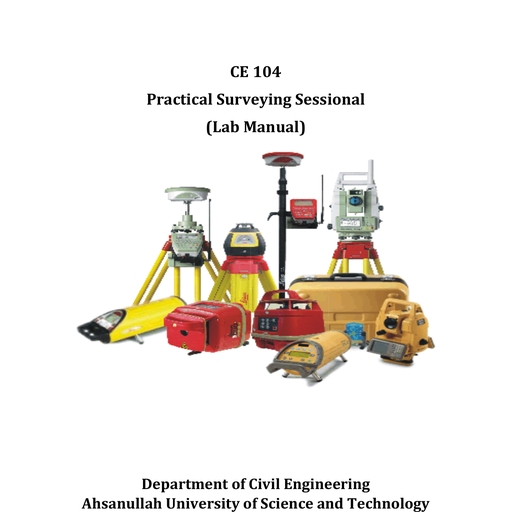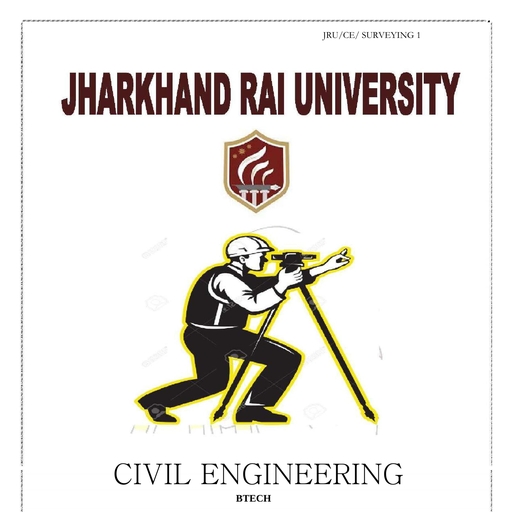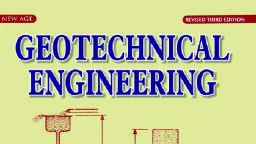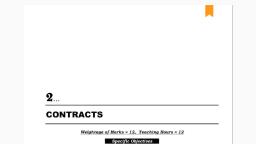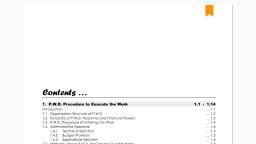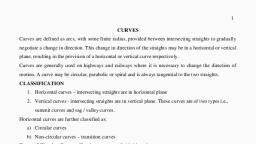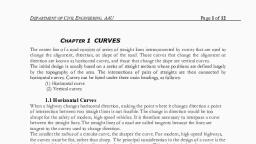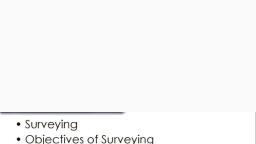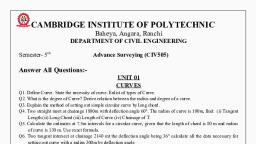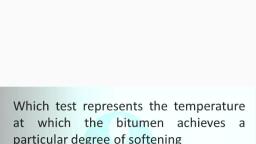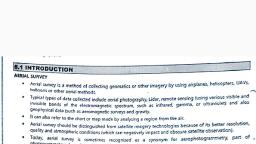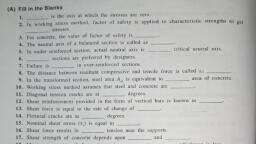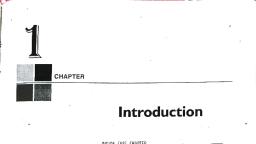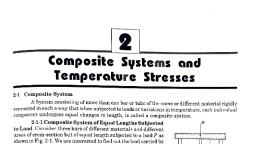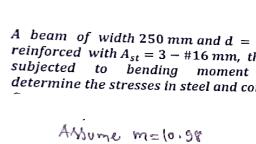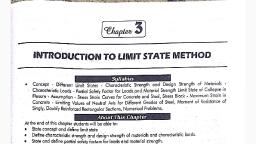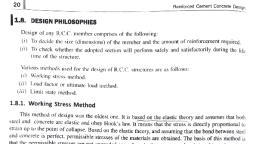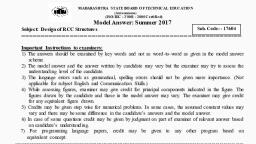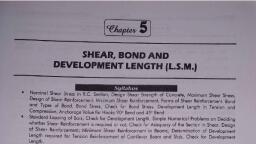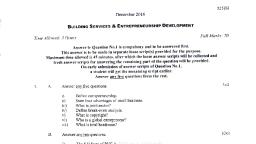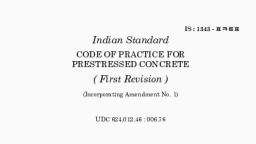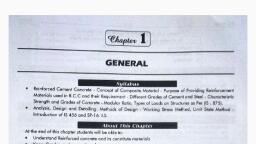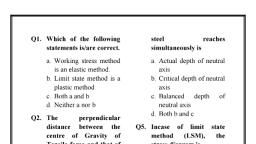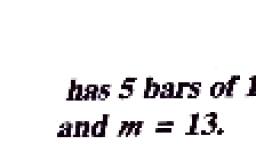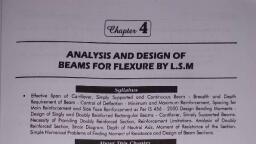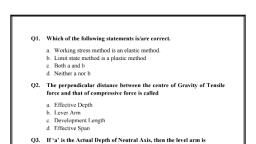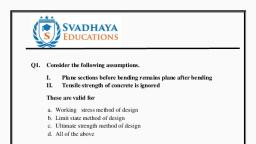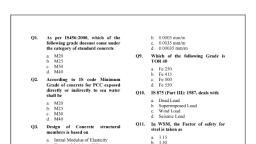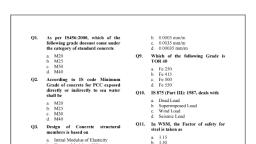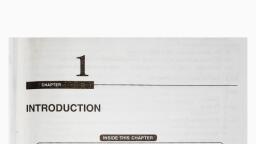Page 1 :
Chapter, INTRODUCTION TO WORKING STRESS METHOD, Syllabus, Assumption made in the Working Stress Method Permissible Stress (IS: 456-2000) Flexural Members, Singly Reinforced Rectangular Section Strain and Stress Distribution due to Bending Actual and, Critical Neutral Axes Under/Over Reinforced Sections Balanced Sections Lever Arm Moment of, Resistance of Singly Reinforced Rectangular Sections (Simple Problems)., About This Chapter, At the end of this chapter students will be able to:, Describe the assumption made in working stress method., Select the permissible stresses in concrete and steel as per IS: 456-2000, Draw the strain and stress distribution diagram for singly reinforced section., Understand neutral axis balanced, under-reinforced and over-reinforced section., Find the moment of resistance and lever arm of singly reinforced rectangular section., Calculate the actual stresses in steel and concrete for given materials and bending moment., Design the singly reinforced section for flexure for given load and span or bending moment., 2.1 INTRODUCTION, The working stress method of design of reinforced concrete structures developed during the, beginning of 20th century is based on elastic theory. In this method, the behaviour of the, structure is assumed to act as linearly elastic body under the action of service (working) loads., The safety of the structure is ensured by restricting the stresses in the materials. The, permissible stresses in concrete and steel are obtained by dividing the characteristic strength of, the material by factor of safety. This method leads to conservative design because safety is, evaluated for a very local effect, whereas the structure may take higher loads. However, the, method was popular because of ease in calculations., 2.2 ASSUMPTIONS IN WORKING STRESS METHOD, 1. Sections that are plane before bending, remain plane even after bending., 2. The stress-strain relationship of steel and concrete under working load is linear., 3. All tensile stresses are taken-up by steel reinforcement only, and the concrete area in, tension zone is neglected., 4. There is perfect bond between steel and concrete., 5. The steel area is concentrated at the centroid of the steel reinforcement., 280, 3 Ocbc, 6. The modular ratio m has the value of, (1 - 1), 1
Page 2 :
RCC Design, Introduction to Working Stress Method, 2-2, 2.3 PERMISSIBLE STRESSES, permissible stresses in concrete and steel in accordance with IS: 456 code are given In, tables 2.1 and 2.2 respectively., Table 2.1: Permissible Compressive Stress in Concrete, All Values in N/mm2, Grade of, Concrete, Permissible Stress in Bond, (Average) for Plain Bars in Tension, (4), Permissible Stress in, Compression, Bending, Direct, (1), (2), (3), Tbd, Ocbc, M 10, 3.0, 2.5, M 15, 5.0, 4.0, 0.6, M 20, 7.0, 5.0, 0.8, M 25, 8.5, 6.0, 0.9, М 30, 10.0, 8.0, 1.0, M 35, 11.5, 9.0, 1.1, M 40, 13.0, 10.0, 1.2, M 45, 14.5, 11.0, 1.3, M 50, 16.0, 12.0, 1.4, Notes:, 1. The values of permissible shear stress in concrete are given in Table 2.1., 2., The bond stress given in col. 4 shall be increased by 25 percent for bars in compression., Table 2.2: Permissible Stresses in Steel Reinforcement, (Clauses B-2.2, B-2.2.1, B-2.3 and B-4.2), Sr., Types of Stress in, No. Steel Reinforcement, Permissible Stresses in N/mm2, Mild Steel Bars, Medium Tensile, Conforming to, Grade 1 of IS 432, Steel Conforming to, IS 432 (Part I), High Yield, Strength, Deformed Bars, (Part 1), Conforming to IS, 1786, (Grade Fe 415), (1), (2), Tension (ost or osv), (3), (4), (5), (1), (a) Upto and including, Half the guaranteed, yleld stress subject to, 20 mm, 140, 230, (b) Over 20 mm, 130, a maximum of, 230, 230, (11) Compression, In, 130, 130, column bars (osc), 190, () Compression in bars The calculated compressive stress in the surrounding concrete, In a beam or slab multiplied by 1.5 times the modular ratio or osc whichever is lower., when the compressive, resistance, of, the, concrete Is taken into, account., contd., 2
Page 3 :
RCC Design, Introduction lo Working Stress Method, 2-3, (iv) Compression in bars, a beam or slab, where the compres-, in, sive resistance of the, concrete is not taken, into account:, Half the guaranteed, yield stress subject to, a maximum of 190, 190, (a) Upto and Including, 140, 20 mm, 190, (b) Over 20 mm, 130, Notes:, 1. For high yield strength deformed bars of Grade Fe 500 the permissible stress in direct, tension and flexural tension shall be 0.55 f,. The permissible stresses for shear and, compression reinforcement shall be as for Grade Fe 415., 2. For welded wire fabric conforming to IS 1566, the permissible value in tension o is, 230 N/mm?., 3. For the purpose of design, the yield stress of steels for which there is no clearly defined, yield point should be taken to be 0.2 percent proof stress., 4. When mild steel conforming to Grade II of IS 432 (Part 1) is used, the permissible stresses, shall be 90 percent to the permissible stresses in col 3, or if the design details have already, been worked out on the basis of mild steel confirming to Grade I of IS 432 (Part I); the area, of reinforcement shall be increased by 10 percent of that required for Grade I steel., 2.4 FLEXURAL MEMBERS, Reinforced concrete structural elements used in various types of structures like beams and, slabs are invariably subjected to flexure or bending while resisting working loads., In this chapter, the analysis of reinforced concrete section subjected to flexure is examined in, details and the method specified in IS: 456-2000 for computation of flexural strength of singly, reinforced rectangular section is presented with practical examples., 2.5 ANALYSIS OF SINGLY REINFORCED CONCRETE SECTIONS, only on tension side is, A section of R.C.C. beam in which steel reinforcement is provided, termed as singly reinforced section., 2.5.1 Strain and Stress Diagrams, Consider a rectangular R.C.C. section as shown in Fig. 2.1., Ocbc, Ocbc, b, N.A., Ost/m, Equivalent bending, stress distribution, diagram, Ost, Section, of beam, Strain, diagram, Bending stress, diagram, Fig. 2.1
Page 4 :
RCC Design, Introduction to Working Stress Method, 2-4, Let,, Breadth of a rectangular beam., Effective depth of section (measured from compression face to the c.g. of, reinforcement)., = Depth of neutral axis below compression edge., Cross-sectional area of steel in tension., Permissible compressive stress in concrete in bending., = Permissible tensile stress In steel., d., Ast =, %3D, Ost, D, Overall depth of beam., = Modular ratio., N.A., %3D, Neutral axis., 2.5.2 Position of Neutral Axis, Case 1: Given, (1) Dimensions of section (b and d)., (ii) Permissible stresses in concrete and steel (ocbc and Ost)., (iii) Modular ratio m., Referring to equivalent stress dlagram, (Fig. 2.2) and considering similar triangles., b, Ocbc, Ocbc, x/3, C, Compression, zone, p.-N, Tension, Ast, d-x, zone, I., Osum, Ost/m, Fig, 2.2, Ocbc, ... (2.1), Case: II: Given, (1) Dimensions of section (b and d)., (II) Area of tension steel (Ast)., (liI) Modular ratio (m)., Moment of compression area about N.A. = b x., %3D, Moment of area of tension side =, Equivalent concrete area of tension steel x (d x), = m: Ast (d - x), As N.A. is situated at the C.G. of a given section, the moment of area on both sides are equal:, bx, = m Ast (d- x), (2.2), 2.5.3 Moment of Resistance (M), The moment of resistance of an R.C.C. section is the moment of couple formed by total tensile, force (T) acting at the C.G. of the reinforcement and the total compressive force (C) In the, concrete acting at the C.G. of compressive stress diagram as shown in Fig. 2.3., The distance between total compressive force (C) and tensile force (T) is called the lever arm, and is denoted by z.
Page 5 :
RCC Deaign, 2.5, Introduction to Working Stress Method, The C.G. of compressive stress triangle is at distance x/3 from compression edge., . Lever arm, d-, Compressive force C =, Average stress x Compression area, xb.x, bx Ocbc, %3D, Tenslle force T, Stress In steel x Area of steel, %3D, Ost Ast, %3D, . Moment of resistance,, M, = Cxz or Txz, b x Ocbc, M, =, ... (2.3), or, M, = Ost Ast (d-, .. (2.4), 2.5.4 Balanced Under-Reinforced and Over-Reinforced Sections, 1. Balanced Section:, If stresses in steel and concrete reach to its maximum value at one and the same time, such, type of section is called 'balanced' or 'critical' or 'economic' section. The neutral axis of this, section is called critical neutral axis (xc) and is obtained as:, Ocbc, Ost/m, d- xc, Ocbc, Ocbc, Terde, Critical, neutral axis, N-d·, 0000, Ost/m, <Ogtim, Section, of beam, Balanced, reinforced, Under, reinforced, Over, reinforced, Fig. 2.3: Equivalent Stress Diagrams, 2. Under-reinforced Section:, If less steel than that required for balanced section is used, the section is, In such section, steel reaches its permissible value of stress first, while the stress produced in, concrete is less than its permissible value., For an under reinforced section, depth of neutral axis (x) is less than xe and x is obtained as:, er reinforced, bx?, = m Ast (d - x) and, 2, M, = Txz, -, Ost Ast (d-, 3. Over-reinforced Section:, If more steel than that required for balanced section is used, the section is over-relnforced.






